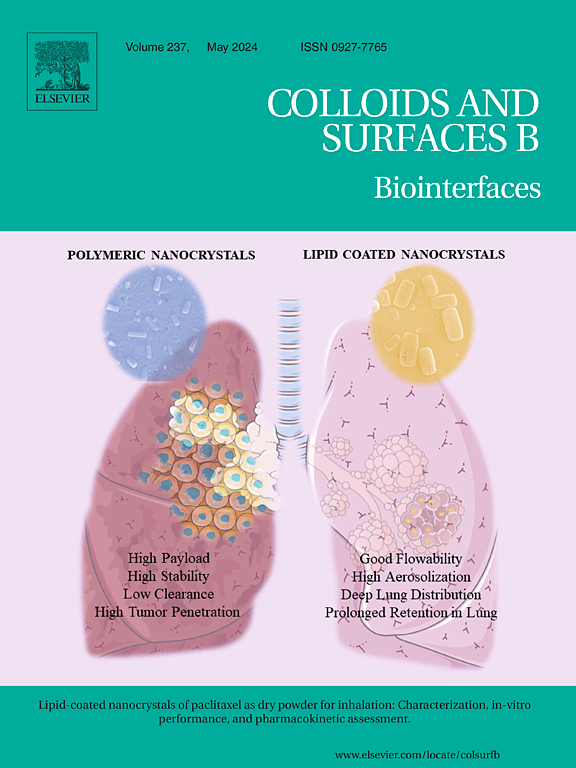Development of paroxetine loaded nanotransferosomal gel for intranasal delivery with enhanced antidepressant activity in rats
IF 5.4
2区 医学
Q1 BIOPHYSICS
引用次数: 0
Abstract
The aim of this study was to develop paroxetine (PXT) loaded nanotransferosomal gel (PXT-NTFG) for intranasal brain delivery. The process involved fabricating PXT-NTFs (paroxetine-loaded nanotransferosomes) through a thin film hydration method and optimizing them based on parameters such as particle size (PS), zeta potential (ZP), polydispersity index (PDI), and entrapment efficiency (EE). The optimized PXT-NTFs exhibited uniform morphology with a PS of 158.30 ± 2.73 nm, low PDI (0.142 ± 0.072), high ZP (21.00 ± 0.75 mV), and excellent EE (88.09 ± 3.40 %). Characterization through various techniques confirmed the incorporation of PXT into the nanotransferosomes and its conversion to amorphous state. Moreover, PXT-NTFG was formulated with suitable viscosity and mucoadhesive properties. In vitro release studies demonstrated sustained drug release from PXT-NTFG at different pH levels as compared to PXT-NTFs and NTF dispersion. Similarly, ex vivo experiments showed 4 folds enhanced drug permeation from PXT-NTFG when compared with PXT conventional gel. Stability studies indicated that the optimized PXT-NTFs remained stable for four months at 4°C and 25°C. Additionally, improved behavioral outcomes, increased neuronal survival rates, and upregulated brain-derived neurotrophic factor (BDNF) expression was observed in lipopolysaccharide (LPS) induced depressed Sprague-Dawley rats after treatment with PXT-NTFG as compared to PXT-dispersion treated and untreated LPS-control groups. Notably, the formulation led to a significant reduction in brain and plasma TNF-α levels. In conclusion, intranasal PXT-NTFG is a promising formulation with sustained drug release, improved brain targeting and enhanced antidepressant activity.
开发用于鼻内给药的帕罗西汀纳米脂质体凝胶,增强大鼠的抗抑郁活性。
本研究旨在开发用于鼻内脑部给药的帕罗西汀(PXT)负载纳米转运体凝胶(PXT-NTFG)。研究过程包括通过薄膜水合法制备 PXT-NTFs(帕罗西汀负载纳米转运体),并根据粒度(PS)、ZP、多分散指数(PDI)和夹带效率(EE)等参数对其进行优化。优化后的 PXT-NTFs 形状均匀,PS 为 158.30 ± 2.73 nm,PDI 低(0.142 ± 0.072),ZP 高(21.00 ± 0.75 mV),EE 优良(88.09 ± 3.40 %)。通过各种技术进行的表征证实了 PXT 被纳入纳米转运体并转化为无定形状态。此外,PXT-NTFG 还具有适当的粘度和粘附性。体外释放研究表明,与 PXT-NTFs 和 NTF 分散体相比,PXT-NTFG 在不同 pH 值水平下都能持续释放药物。同样,体内外实验表明,与 PXT 传统凝胶相比,PXT-NTFG 的药物渗透率提高了 4 倍。稳定性研究表明,优化后的 PXT-NTF 在 4°C 和 25°C 温度下可保持稳定四个月。此外,与 PXT 分散液处理组和未经 LPS 处理的对照组相比,使用 PXT-NTFG 处理后,脂多糖(LPS)诱导的 Sprague-Dawley 抑郁大鼠的行为结果得到改善,神经元存活率提高,脑源性神经营养因子(BDNF)表达上调。值得注意的是,该制剂显著降低了脑部和血浆中 TNF-α 的水平。总之,鼻内PXT-NTFG是一种很有前景的制剂,它具有持续的药物释放、更好的脑靶向性和更强的抗抑郁活性。
本文章由计算机程序翻译,如有差异,请以英文原文为准。
求助全文
约1分钟内获得全文
求助全文
来源期刊

Colloids and Surfaces B: Biointerfaces
生物-材料科学:生物材料
CiteScore
11.10
自引率
3.40%
发文量
730
审稿时长
42 days
期刊介绍:
Colloids and Surfaces B: Biointerfaces is an international journal devoted to fundamental and applied research on colloid and interfacial phenomena in relation to systems of biological origin, having particular relevance to the medical, pharmaceutical, biotechnological, food and cosmetic fields.
Submissions that: (1) deal solely with biological phenomena and do not describe the physico-chemical or colloid-chemical background and/or mechanism of the phenomena, and (2) deal solely with colloid/interfacial phenomena and do not have appropriate biological content or relevance, are outside the scope of the journal and will not be considered for publication.
The journal publishes regular research papers, reviews, short communications and invited perspective articles, called BioInterface Perspectives. The BioInterface Perspective provide researchers the opportunity to review their own work, as well as provide insight into the work of others that inspired and influenced the author. Regular articles should have a maximum total length of 6,000 words. In addition, a (combined) maximum of 8 normal-sized figures and/or tables is allowed (so for instance 3 tables and 5 figures). For multiple-panel figures each set of two panels equates to one figure. Short communications should not exceed half of the above. It is required to give on the article cover page a short statistical summary of the article listing the total number of words and tables/figures.
 求助内容:
求助内容: 应助结果提醒方式:
应助结果提醒方式:


